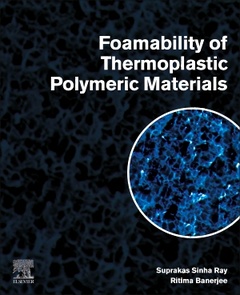Description
Foamability of Thermoplastic Polymeric Materials
Authors: Ray Suprakas Sinha, Banerjee Ritima
Language: English
Subjects for Foamability of Thermoplastic Polymeric Materials:
Keywords
?Acoustic; Applications; Batch foaming; Bead foaming and film foaming; Biodegradable thermoplastics; Blends; Block copolymer; Cell density; Cell stabilisation; Cell-size distribution; Challenges; Composites; Compression foam moulding; Current status; Degradation characteristics; Equilibrium and nonequilibrium aspects; Extrusion foaming; Filler location; Fillers; Fillers distribution and dispersion; Foam properties; Foamability; Foamability of thermoplastic polymers; Foaming process; Foams; Future outlook; Gas dissolution theories; Influence; Injection foam moulding; Morphology development; Multiphase polymeric materials; Nanocomposites; Packaging; Polymer foams; Polymeric foams; Porosity; Processing conditions; Review; Rheological characteristics; Rotational foam moulding; Scaffolds; Superinsulation; The ratio of the density unfoamed versus foamed material; Theories of nucleation and cell growth; Thermoplastic polymers; Thermoset reactive foaming; Transport phenomenon
208.67 €
In Print (Delivery period: 14 days).
Add to cart296 p. · 19x23.4 cm · Paperback
Description
/li>Contents
/li>Biography
/li>Comment
/li>
Foamability of Thermoplastic Polymeric Materials presents a cutting-edge approach to thermoplastic polymeric foams, drawing on the latest research and guiding the reader through the fundamental science, foamability, structure-property-processing relationship, multi-phase polymeric materials, degradation characteristics of biodegradable foams and advanced applications. Sections provide detailed information on foam manufacturing technologies and the fundamental science behind foaming, present insights on the factors affecting foamability, cover ways of enhancing the foamability of various polymeric materials, with special focus on multi-phase systems, discuss the degradation of biodegradable foams and special morphology development for scaffolds, packaging, acoustic and super-insulation applications, as well as cell seeding studies in scaffolds.
Each application has specific requirements in terms of desired properties. This in-depth coverage and analysis helps those looking to move forward with microcellular processing and polymer foaming. This is an ideal resource for researchers, advanced students and professionals interested in the microcellular processing of polymeric materials in the areas of polymer foaming, polymer processing, plastics engineering and materials science.
1. Introduction to polymer foams and foaming 2. Foam manufacturing technologies 3. The science behind foaming 4. Foamability of thermoplastics 5. Foamability of multiphase polymeric materials 6. Foamability for special applications 7. Degradation studies of biodegradable foams 8. Conclusions and future outlook
Dr. Ritima Banerjee completed her Masters in Polymer Science and Technology at the Indian Institute of Technology, Delhi (IITD), India. After working in the polymer industry (GE Plastics and SABIC) for 7 years, she returned to academia. She taught in Delhi Technological University for two years and subsequently completed her PhD from the Department of Materials Science and Engineering, IITD, the area of her work being microcellular processing of thermoplastic elastomer based blends and nanocomposites. She is presently a faculty member in the Department of Chemical Engineering in Calcutta Institute of Technology, India. Her research interests include microcellular processing and the structure-property-processing relationship of polymeric materials.
- Offers in-depth coverage of factors affecting foamability and methods for enhancing the foamability of polymeric materials
- Explores innovative applications in a range of areas, including scaffolds, acoustic applications, packaging and super-insulation
- Provides a comprehensive, critical overview of the state-of-the-art, possible future research directions, and opportunities for industrial application
These books may interest you

Polymer Nanocomposite Foams 93.24 €



